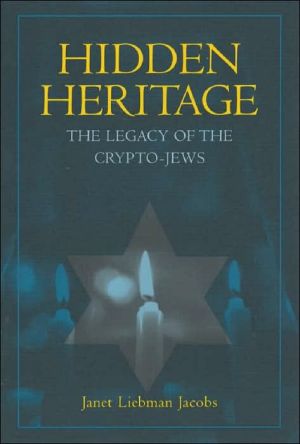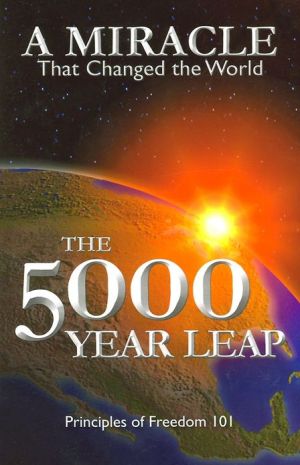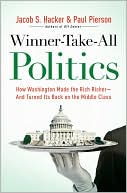Hidden Heritage: The Legacy of the Crypto-Jews
This study of contemporary crypto-Jews—descendants of European Jews forced to convert to Christianity during the Spanish\ Inquisition—traces the group's history of clandestinely conducting their faith and their present-day efforts to reclaim their past. Janet Liebman Jacobs masterfully combines historical and social scientific theory to fashion a brilliant analysis of hidden ancestry and the transformation of religious and ethnic identity.
Search in google:
"Janet Jacobs enters fearlessly into the house of mirrors that is Jewish-Hispanic identity, where nothing is what it appears to be. Her ethnography is about the uses of silence and the excuses of memory."—Ilan Stavans, author of On Borrowed Words: A Memoir of Language"Janet Jacobs's book is a beautifully written, compelling account of the experiences of contemporary crypto-Jews who are struggling to locate the meanings of their various identities. I know of no other works that cover this material, and Jacobs does so in a rich finely nuanced way in which she deals with issues of family, memory, community, and belonging. I love the way she draws on such a wide variety of materials to explore this topic in a wide-ranging and impressive way."—Lynn Davidman, author of Tradition in a Rootless World Lynn Davidman Janet Jacobs's book is a beautifully written, compelling account of the experiences of contemporary crypto-Jews who are struggling to locate the meanings of their various identities. I know of no other works that cover this material, and Jacobs does so in a rich finely nuanced way in which she deals with issue of family, memory, community, and belonging. I love the way she draws on such a wide variety of materials to explore this topic in a wide-ranging and impressive way.
Hidden Heritage\ The Legacy of the Crypto-Jews \ \ By Janet Liebman Jacobs \ University of California\ Copyright © 2002 Regents of the University of California\ All right reserved.\ ISBN: 0-520-23517-7 \ \ \ Chapter One\ Conversion and the Rekindling of the Jewish Soul \ For a little more than half the descendants who participated in this study, the discovery and exploration of their Jewish ancestry resulted in conversion and the adoption of a Jewish religious worldview. These descendants identify both spiritually and culturally with modern Judaism and with the religious heritage of their Sephardic ancestors. While attachment to crypto-Jewish family members is an important part of nurturing an emotional connection to Judaism (see chapter 4), the decision to convert is informed by a diverse set of circumstances that the descendant brings to the conversion experience. For some descendants, converting to Judaism marks the end of a long search for a meaningful spiritual tradition, while for others, Judaism is appealing because it resonates with the descendant's prior religious orientation. Thus, one descendant chose Judaism after experimenting with Buddhism and Hinduism and another because the study of Torah was similar to her study of scripture in the Assemblies of God Church. In the latter case, the descendant recalled:\ In my growing up as a Protestant, we read what I now know to be the Torah. And with such love for Israel, you know, it sounded like there's this love for the community and God's special relationship to Israel.... the fundamentalist element in Mexico and Latin America is what I've now come to understand as the survival of the essence of the Torah.\ Because the descendants come to Judaism from widely different backgrounds and spiritual paths, their varied encounters both with the religion and with the conversion process illuminates the multifaceted nature of Jewish conversion in contemporary society. The narratives therefore reveal the intersecting and dynamic relationship among law, history, and theology in the modern construction of Jewish religious identity. Accordingly, a discussion of the legal issues affecting conversion provides a good starting point from which to consider the religious response to ancestral Judaism among modern crypto-Jewish descendants.\ MODES OF CONVERSION AND THE POLITICS OF JEWISHNESS\ Within the contemporary discourse on Jewish conversion, the questions surrounding birthright and Jewish legal status are especially salient for crypto-Jewish descendants, since ancestral attachments have different meanings within the spectrum of religious orientations that comprise Jewish thought and practice. According to Jewish law, the most important signifier of Jewishness is being born of a Jewish mother. Thus, in Orthodox and Conservative traditions, conversion is required of all those who cannot trace matrilineal descent, even if the father is Jewish by birth. The legal definition of Jewishness stipulates that any child born of a Jewish mother is by law Jewish, regardless of what future religious paths the mother, father, or child may take.\ The emphasis on maternal religious inheritance can be explained from a social and political perspective that locates concerns about Jewish lineage within a biblical and historical framework. The religious rationale for matrilineal descent is derived from a passage in Deuteronomy that prohibits a Jewish father from arranging a marriage between his child and a gentile. The directive from God is contained within a series of commands that God gives to the Jews as they are about to enter the land of Israel after exile in Egypt. In these Torah passages, God directs the Jews to cast out all other nations and expressly prohibits intermarriage between Jews and non-Jews:\ 2. and when the Lord thy God shall deliver them [the Hittites, Girgashites, and Cannanites] up before thee, and thou shall smite them: then thou shalt utterly destroy them; thou shalt make no covenant with them, nor show mercy unto them; 3. neither shalt thou make marriages with them: thy daughter thou shalt not give unto his son, nor his daughter shalt thou take unto thy son. 4. For he will turn away thy son from following Me."\ The prohibition on intermarriage reflects anxiety about Jewish constancy, since it is feared that the child born of a Jewish mother and a non-Jewish father will reject the Jewish faith and, more significantly, the God of Israel. Talmudic interpretation of this passage concluded that a child born of a union between a gentile father and Jewish mother is, by law, a Jew, because the child in the Deuteronomy passage is considered the child of the mother's father, the Jewish patriarch to whom this commandment is directed. Through this reasoning, it is the maternal grandfather through whom Jewish lineage is actually inherited. Modern Jewish commentary on the Talmud's view of the Deuteronomy passage thus explains matrilineal descent in the following manner:\ Since the Torah, on this interpretation, calls the child of an Israelite mother and gentile father the "son" of an Israelite grandfather, it was deduced therefrom that the child is to be regarded as being of the same race and faith as the mother. Consequently, the child of a Jewish father and non-Jewish mother follows in Jewish Law the religious status of the mother.\ While the religious rationale for matrilineal descent offered by Talmudic scholars reinforced the primacy of the Jewish patriarch and his legal authority over his daughter's child, other explanations maintain that matrilineal descent developed in response to concerns over paternity. Within this interpretive framework, the importance of the mother's Jewishness in religious law can be explained in terms of the effects of rape and foreign acculturation on Jewish survival. According to this perspective, historically the survival of Jewish culture was at risk because of both intermarriage and sexual violation among a people who were constantly at war and under foreign domination. Religious inheritance through the mother therefore sustained the Jewishness of the child, regardless of the religion or nationality of the father.\ Whether the religious laws were intended to establish the primacy of the Jewish patriarch or to deflect fears surrounding unknown or non-Jewish paternity, the result of matriarchal descent has been the development and maintenance of legal codes that today perpetuate a biological definition of Jewishness linking blood to religiosity and race to beliefs. As a legal construct, the transmission of Jewishness through the mother has grown in importance in recent decades, placing crypto-Jewish descendants in a contested arena of Jewish identity where traditional laws governing conversion limit access to membership in the religious community. Thus, Marc Angel, a leading Sephardic rabbi in the United States, while expressing kinship with Spanish crypto-Jewish descendants, nonetheless maintains that unless matrilineal descent can be established, conversion is required before they can be recognized as Jews:\ When Jewish spokesmen tell the people in New Mexico that they are accepted as Jews because they have gone through a lot, because they love Judaism, because they have ancestors who were Jews several hundred years ago-they are misleading these individuals ... a compassionate and wise guide would tell them that he is glad of their interest in embracing Judaism, and that to be accepted as Jews they should follow the necessary procedure: halakhic conversion. In this way these individuals can achieve a genuine and universal acceptance among the Jewish people.\ Within the boundaries set by Angel and other Orthodox religious authorities, only one descendant in this study was recognized as Jewish through blood ties to the mother. In this case, the descendant's mother suffered from Creutzfeldt-Jacob disease, a degenerative disease of the central nervous system that has been linked specifically to Sephardic ancestry. When the descendant approached a rabbi in Colorado, she was told that because of her mother's illness, she would not have to go through a formal conversion before beginning the practice of Judaism: The rabbi said, "You're Jewish. It doesn't make any difference if you are an atheist, you are Jewish. You don't have to convert. You can just start practicing the laws if that's what you want to do." In recalling this aspect of her search for Jewish roots, she spoke of both the relief and sadness that accompanied her mother's diagnosis and the rabbi's affirmation of her Jewish lineage:\ It was great to find out positively that I was Jewish. I had already been researching it, so I was pretty sure that we were Jewish. So I was relieved that I didn't have to research my mother's side anymore. We knew my mother was ill. We knew she had a condition that wasn't getting any better. You know, it was hard knowing that my mother was ill in the first place. That was pretty tough. So the emotions were kind of mixed, because I was relieved that we were Jewish, but, you know, it's heartbreaking to see your mother go through that.\ For the vast majority of descendants whose "birthright" remains a more complicated and disputed area of religious identity, decisions to convert invited a wide array of responses from others. For some descendants, external recognition of Sephardic ancestry lies at the heart of their conversion dilemma. A woman of Mexican descent recounted a trip to Israel in which she brought along her genealogical documents with the hope that the rabbinic authority would recognize her blood ties to Judaism:\ I went to the chief rabbi, and I brought him a write-up of my whole story. I demanded to be heard, to be accepted, and I never even saw him. They would not even allow me to present my case to him. The deep pain, the deep rejection, that I felt when I left there. But then I recovered. I remembered that Hashem [God] knows all that counts. I did not need this rabbi to make me a Jew.\ Other descendants voiced similar feelings of disappointment and anger when their Jewishness was called into question:\ When I was twelve or thirteen, my dad took me to see a rabbi, and he was a Conservative rabbi, and he starts asking me about my mother and her family. I wanted a bar mitzvah. I wanted to read Hebrew, but that's not what happened. To me, I made the commitment when I was thirteen. I've lived it as much as I can every day. I've done everything to educate myself in my own way. When rabbis would talk to me I would listen.... When I lived in Venezuela, I went to a synagogue. I went to the rabbi's office and told them that I would be there for a year and that I wanted to join the synagogue. So I went to see the rabbi, and the first thing he says is, "You don't have a Jewish name." He wanted me to get a letter from my rabbi here and send it to him verifying who and what I was. The entire year I was down there, I never once went to that temple. I didn't bother.... I walked by there every day. It really upset me. It was a beautiful temple. I was miserable.\ In response to his rejection by mainstream Judaism, this descendant started attending a Lubavitcher synagogue in the United States, where he is permitted to read from the Torah and where his Jewish authenticity has not been challenged. Other descendants have found similar affirmation in synagogues in Europe. A descendant who was raised in South America took her family genealogy to a rabbi in Portugal who without question accepted her as a Jew:\ I went to the rabbi and I explained to him about my history. I took all the papers and pictures of my family, and they believed me! The synagogue and the people over there-it was like being in your own land, and you come to them and tell them you are here, and they accept you.\ As exemplified by these diverse accounts, the indeterminate status of crypto-Jewish descendants has raised difficult and troubling issues within Jewish legal circles, since rabbis from different sectors of the Jewish community have taken various approaches to the question of conversion. Within the liberal sector of Reform Judaism, a small number of rabbis in the United States have created special ceremonies welcoming the descendants into Judaism. One such ceremony at a Reform synagogue in the Southwest brought a number of descendants together in a rite of return. In this special service, participants held the Torah as they recited prayers, publicly declaring their commitment to Judaism. Although a portion of the descendants have embraced rites of return such as these, the majority of participants who identify as Jewish have chosen to undergo a more traditional conversion. As one male descendant explained:\ The fact that I was Jewish once upon a time, I mean by ancestry and blood, is not enough, because I never practiced Judaism. I never studied Judaism. So how could I say that I was a Jew? ... My personal opinion, in my case, was that, yes, my ancestors were Jews, but I was not. And maybe I wasn't a Christian, either, so I was nothing. But in order to become a Jew, I thought the first thing I had to do was to study Judaism and then I have to be circumcised, which is what I did.\ Once an individual decides to convert, she or he must then decide which denomination of Judaism to pursue. Depending on whether a descendant seeks membership in an Orthodox, Conservative, or Reform synagogue and whether the congregation is Sephardic or Ashkenazic, the conversion experience will vary greatly. Although all forms of Jewish conversion require the convert to make a commitment to follow the commandments of the Torah, the extent to which the commandments are studied and observed will differ according to the orthodoxy of the congregation and the prerogatives of the supervising rabbi. Differences also exist in conversion policies over the requirements of circumcision (for the uncircumcised) and ritual immersion.\ Among the Orthodox, conversion requires intensified instruction in Torah, circumcision for males, and ritual immersion, all of which are overseen by a bet din, a rabbinic court made up of three Orthodox rabbis. The Conservative Movement, which takes a more moderate yet traditional approach, also requires instruction in Torah, circumcision, and ritual immersion. Here, however, the rabbinic court need not be composed of Orthodox rabbis. The Reform Movement, the most liberal of the three approaches, involves some religious training and education but does not usually require circumcision and ritual immersion. These variations within Judaism are further complicated by the dilemma posed by the Orthodox authorities, who will only accept a Jewish convert whose bet din is comprised of Orthodox rabbis.\ \ (Continues...)\ \ \ \ Excerpted from Hidden Heritage by Janet Liebman Jacobs Copyright © 2002 by Regents of the University of California . Excerpted by permission.\ All rights reserved. No part of this excerpt may be reproduced or reprinted without permission in writing from the publisher.\ Excerpts are provided by Dial-A-Book Inc. solely for the personal use of visitors to this web site. \ \
AcknowledgmentsIntroduction: Crypto-Jewish Descent: An Ethnographic Study in Historical Perspective11Secrecy, Antisemitism, and the Dangers of Jewishness212Women and the Persistence of Culture: Ritual, Custom, and the Recovery of Sephardic Ancestry423The Self-in-Relation and the Transformation of Religious Consciousness674Syncretism and Faith Blending in Modern Crypto-Judaism835Conversion and the Rekindling of the Jewish Soul1006Jewish Ancestry and the Social Construction of Ethnic Identity125Conclusion: Ethnic Loss and the Future of Crypto-Jewish Culture149Notes155Selected Bibliography177Index187
\ Ilan StavansJanet Jacobs enters fearlessly into the house of mirrors that is Jewish-Hispanic identity, where nothing is what it appears to be. Her ethnography is about the uses of silence and the excuses of memory.\ \ \ \ \ Lynn DavidmanJanet Jacobs's book is a beautifully written, compelling account of the experiences of contemporary crypto-Jews who are struggling to locate the meanings of their various identities. I know of no other works that cover this material, and Jacobs does so in a rich finely nuanced way in which she deals with issue of family, memory, community, and belonging. I love the way she draws on such a wide variety of materials to explore this topic in a wide-ranging and impressive way.\ \








